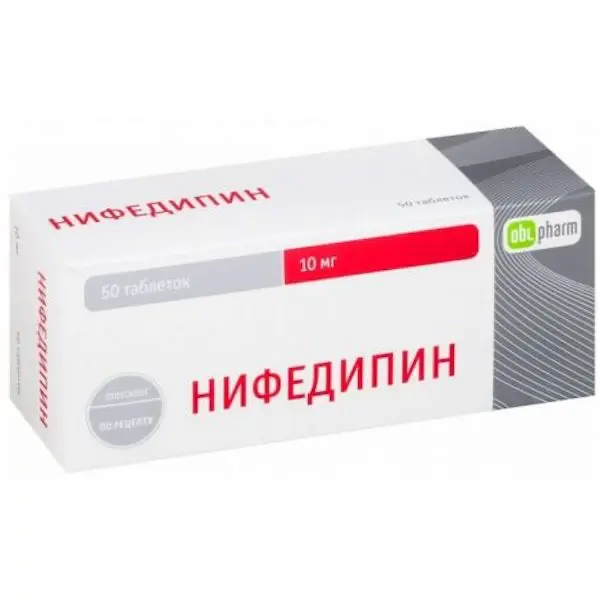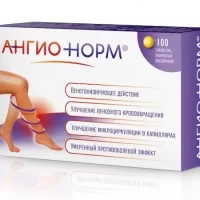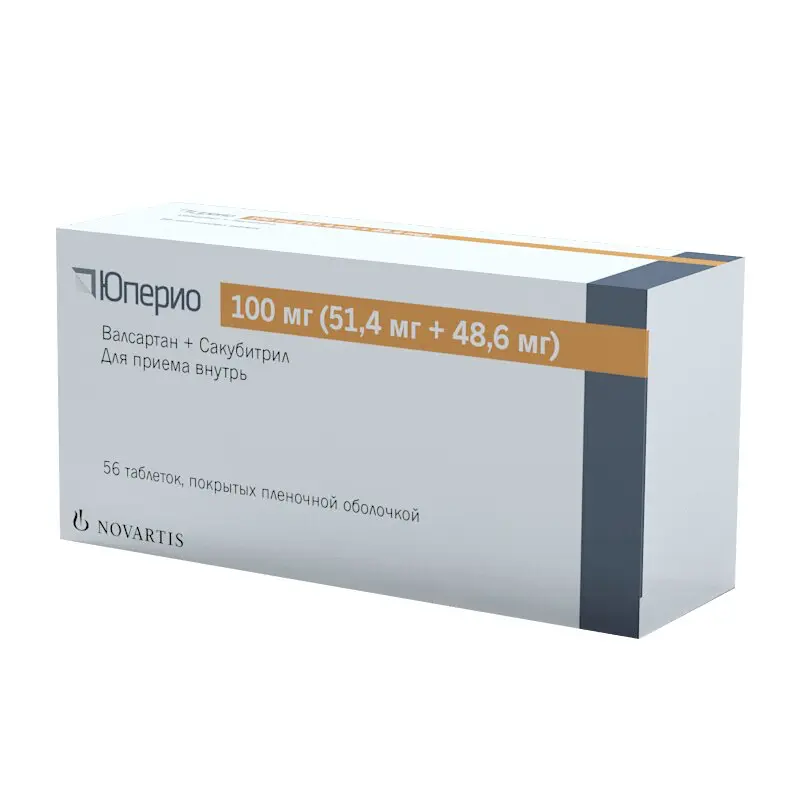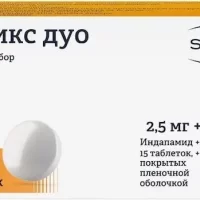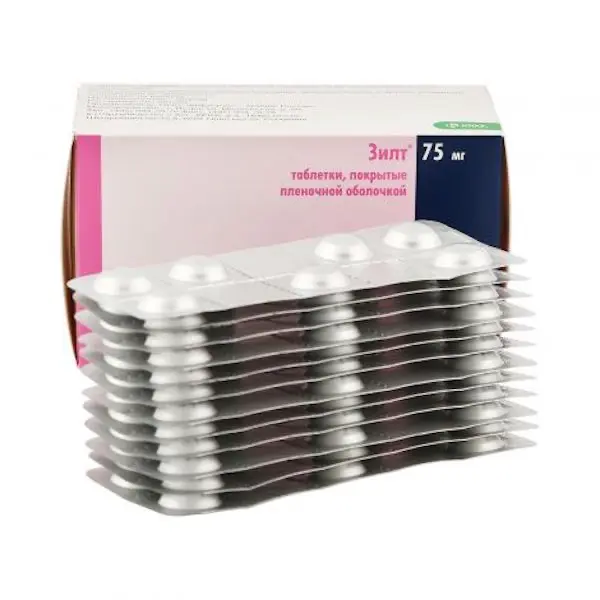Description
Nifedipine Pharmacodynamics
Nifedipine is a selective “slow” calcium channel blocker (BMCC) derivative of 1,4-dihydropyridine.
It dilates coronary and peripheral arteries, reduces myocardial oxygen demand by reducing the post-load on the heart and oxygen delivery. Increases coronary blood flow, improves blood supply to ischemic zones without development of the “bypass” phenomenon, activates collaterals. By dilating peripheral arteries, it reduces total peripheral vascular resistance (TPR), myocardial tone, afterload, myocardial oxygen demand and increases duration of left ventricular (LV) diastolic relaxation.
It has almost no effect on the sinoatrial and atrioventricular nodes. Does not have antiarrhythmic and proarrhythmogenic effects.
Does not affect the tone of the veins.
Nifedipine increases renal blood flow, causing moderate natriuresis.
The negative chrono-, dromo- and inotropic effects of nifedipine are overridden by reflex activation of the sympathoadrenal system and increased heart rate (HR) in response to peripheral vasodilation. Predominantly at the beginning of therapy, heart rate and cardiac output may decrease as a result of baroreceptor reflex activation. During prolonged therapy with nifedipine, heart rate and cardiac output return to the values they had before the start of therapy.
Nifedipine has antihypertensive and antianginal action.
In arterial hypertension, nifedipine reduces blood pressure (BP) due to peripheral vasodilation and reduction of RPS. When taken once daily, nifedipine provides 24-hour control of elevated BP. In patients with normal BP, nifedipine has little or no effect on BP.
In angina patients, nifedipine reduces peripheral and coronary vascular resistance, resulting in increased coronary blood flow, cardiac output, and stroke volume, as well as decreased postload. In addition, nifedipine dilates both intact and atherosclerotically altered coronary arteries, prevents coronary artery spasm, and improves perfusion of ischemic myocardium. Nifedipine reduces the frequency of angina attacks and ischemic ECG changes, regardless of whether they are caused by coronary artery spasm or atherosclerosis.
Indications
– Arterial hypertension (in monotherapy or in combination with other hypotensive agents).
– stable angina pectoris and vasospastic angina pectoris (Prinzmetal’s angina pectoris, variant angina pectoris).
Contraindications
– Hypersensitivity to nifedipine, other dihydropyridine derivatives or to any other component of the drug.
– Moderate to severe hepatic insufficiency (classes B and C according to Child-Pugh classification).
– Cardiogenic shock.
– Collapse.
– Severe arterial hypotension (systolic blood pressure below 90 mm Hg).
– Acute period of myocardial infarction (during the first 4 weeks).
– Unstable angina pectoris.
– Hemodynamically significant left ventricular outflow tract obstruction (including severe aortic stenosis).
– Concomitant use with rifampicin (because effective plasma levels of nifedipine cannot be achieved due to enzyme induction).
– Pregnancy (up to 20 weeks).
– Breast-feeding period.
– Age under 18 years (efficacy and safety not established).
– Rare hereditary galactose intolerance, lactase deficiency, glucose-galactose malabsorption syndrome (the drug contains lactose).
How to use and dosages.
- Inside.
- Tablets should be taken without chewing, with water. Tablets should not be crushed or divided. Do not wash down the tablets with grapefruit juice.
- Doses of nifedipine should be selected individually, depending on the severity of the disease and the therapeutic effect.
- Arterial hypertension.
The recommended initial dose of nifedipine in arterial hypertension is 10 mg twice a day. Subsequently, the dose may be increased to 20 mg 2 times a day, if necessary, to 80-120 mg per day. In most cases, it is recommended to increase the dose at 7-14 day intervals, since this allows to fully assess the effectiveness and tolerability of the previously prescribed dose. However, if necessary, a more rapid dose increase is possible, provided that the patient’s condition is closely monitored. The maximum single dose of nifedipine is 20 mg (2 tablets). It is not recommended to increase daily dose of nifedipine over 120 mg. - Stable angina pectoris and vasospastic angina pectoris
The recommended initial dose of nifedipine in angina pectoris is 10 mg 3 times daily. - Thereafter, a gradual increase in the dose by 10 mg after 4-5 days is possible. If necessary, a more rapid dose increase is possible with close monitoring of the patient’s condition.
- The usual maintenance dose of nifedipine for stable angina pectoris is 10-20 mg 3 times daily.
- Some patients (especially those with vasospastic angina) require an increase in the dose and/or the number of times the drug is administered. In such cases, nifedipine may be used in a dose of 20-30 mg 3-4 times daily (preferably in the form of sustained-release tablets).
- Maximum single dose of nifedipine is 20 mg (2 tablets). It is not recommended to increase daily dose of nifedipine over 120 mg.
- Patients receiving combined antianginal or hypotensive therapy are usually prescribed lower doses of nifedipine. If a daily dose of nifedipine in excess of 40 mg is required for the treatment of arterial hypertension or angina pectoris, prescribing nifedipine preparations from other manufacturers in the form of sustained-release tablets in doses of 20 mg, 30 mg, 40 mg or 60 mg is recommended.
- Special patient groups
- Elderly
The pharmacokinetics of nifedipine are altered in elderly patients (over 65 years of age) and therefore the maintenance dose of the drug may be reduced compared to younger patients. - Patients with impaired hepatic function
In patients with mild hepatic dysfunction, the dose of nifedipine should be reduced.
The drug is contraindicated in patients with moderate and severe hepatic impairment (classes B and C according to Child-Pugh classification). - Patients with impaired renal function
No dose adjustment of nifedipine is required in patients with impaired renal function.

